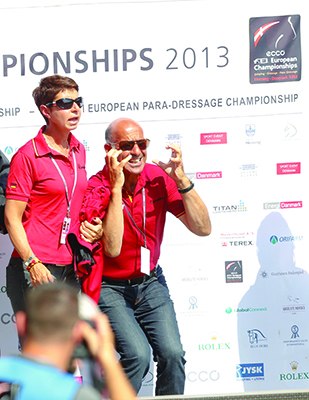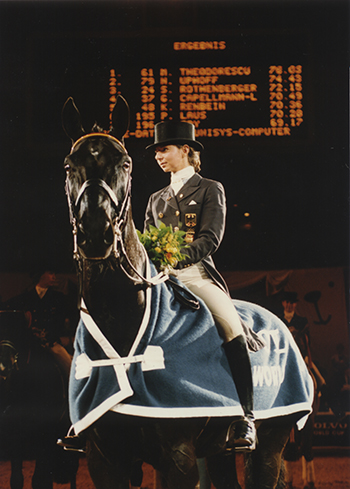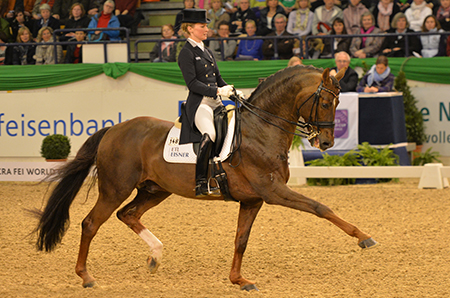I’m not sure when we first started visiting Gestüt Lindenhof, but it has long been one of our favorite spots in Germany. This time it was the first time we’d been there since Georg Theodorescu died, but there was still the same calm, civilized feel to the establishment – but of course, since Georg’s daughter, Monica is very much heir to the tradition established by her father and mother, Inge.
But there have been changes, ever since Monica was appointed German team coach; she has scaled back the activities at Lindenhof, although she continues to teach a number of very lucky pupils, and that list was just increased by one, when German team member, Kristina Sprehe finally decided that the drive to Hagen to the Koschels, was just too much, and she is now training with Monica.

Monica and co-trainer Jonny Hilberath watch on in shock as Helen Langehanenberg has an error of course in her Grand Prix Special at the 2013 Euros
Monica had a very pleasant start to her coaching career, achieving a gold medal at the European Championships – not surprisingly, she enjoyed the occasion…
“Herning was a nice competition to be at, often there are all sorts of restrictions, don’t go here, don’t go there, don’t do this, you are not allowed in there, but it was really nice and friendly.”
It was nice the horses at the top were all ridden in a horse friendly way…
“There are a lot of horses with quality, we are seeing more horses that are really special. You can see that it is just the form on the day that counts. The first three, four, five, could have all been good enough for a medal.”
The style of dressage has changed; there is a big difference between Salinero and Valegro…
“Of course, they are completely different horses. I think we are back to suppleness and relaxation, and definitely it is nicer to watch. I didn’t see one stressed horse there. Of course it is stress to go in such a big arena, but not in a negative way.”
To have such good competition that it was down to the last ride to decide who was going to win the medal…
“That was really good for the sport. It’s good when there is a lot of competition, and even better for us when we win. At the end it all went well for us.”
I was thinking about it, and it is nice for you as coach, because in former times, Germany was expected to win the gold medal every time, and if you didn’t it was a disaster, now you are not expected to win every championship and there is not so much pressure on you…
“As a rider in the team when everyone thought Germany was going to win, that was a lot of pressure, because you could only be so stupid as to make the team lose the gold medal. If you didn’t ride well enough, you could only be the stupid one, and no one wanted to be that stupid one who lost the gold medal. That put on a lot of pressure on. Now it is a different kind of pressure, you want to win, but you are trying your best and maybe another team is better. As long as you do your best it doesn’t mean you have lost anything. Four years ago in Windsor, we were fighting for a bronze medal. But it didn’t feel like it was before, where you felt you can’t even go out of the ring if you miss that gold medal, you can’t even go back to Germany.”
“Now sometimes the other teams are better, at Windsor it was tough to get the bronze, it could have been the Danish team. Now you don’t feel like ‘oh my god we lost a gold medal’ it is more like we did well enough to secure the bronze.”
Does it feel much different to be the coach not the rider?
“Not so different, you just feel like you want to pull on your boots and get your horse out of the stable. Otherwise, it is not so different. There is much more to do and to think about. Every word I say is so important, you can’t just say something without thinking. As a rider you are just concerned about yourself and the horse, now I have to think for a few more of them.”
Even for such an experienced rider as Isabell who made a mistake with her times at Aachen…
“Surprise, surprise, she was a horse too early. All of a sudden she said, take off the bandages, and I said to her, there is one more horse, and she said, what do you mean! No!! Yes. Where is he? Over there. I thought she would see that, and the Rolex clock, but things happen, even at Aachen when you have something in your mind.”
Is it a different dynamic that you have been recently a rider and the riders can relate to you?
“Harry Boldt had competed not so long before he became coach.”
Yours is more of a team effort, I see Jonny Hilberath up there with you in the stand and in the warm-up arena…
“Jonny is my assistant. There is much more to do than there was in the 80s or 90s. Then it was just the team and the long-listed riders that Harry had to take care of. Now it is much more. It starts with young riders under 25; Jürgen Koschel helps with them. There are many more shows than we had before, there is much more to do than take care of a few top horses. There are the young horse championships, the selection trials for the World Young Horse Championships, the World Cups, it is a non-stop all year job now. We do more clinics, and I go to a lot of riders – I am visiting them almost every week.”
You are still riding yourself?
“I do here in the mornings when I can. I still have some students here, but less from foreign countries because I can help them here, but I can’t help them at international shows any more. I have a very good Bereiter, and she takes the young horses out, and takes care of clients’ horses. We still need to have this place running. I also have some riders who come here with a few horses for training for a couple of days. But we just have a few – not 40 like it was, that would be impossible.”

Monica in her competition days with Ganimedes
In the German system, a rider’s individual trainer can help them at a Championship – Mr Koschel was helping Kristina Sprehe at Herning…
“Of course. The horse spends most of the time in Mr Koschel’s stable, and she trains there. But I also go there before the big shows, and see how the horse is, so I am involved. Not getting to a show and ‘oh, that’s what is happening’ – then you get a problem in the communication. We have a very open communication with the riders’ own trainers, and the ones that don’t have a trainer; I have a very easy and open relationship with them. I have to know the horses, what they need, what they do, otherwise I can’t help.”
What does your selection process look like – say in the run up to the WEG?
“We will have the same trials as always, the German Championships in Balve and then Aachen. Also we consider other shows – we take notice of the top horse and rider combinations, wherever they are going: Wiesbaden, World Cup Finals. We see who needs to do what. We keep an eye on them throughout the year.”
But usually the top four at Aachen make the team…
“Not for Herning, Kristina did not go to Balve, and it has been the same in other years. We select the team for Aachen at Balve, and if the riders want to get on a team, they have to do that. But of course, if a horse had a problem, and he needs more time, we can give it to him, like we did with Kristina and Desperados. After he was injured in Goteborg, we gave him a little more time to get fit, not to go to Balve, and to go to Aachen but in the CDI class. We couldn’t name her in the Aachen team because she was not at Balve – as it turned out, it was a good tryout for Fabienne (Lütkemeier with D’Agostino), she was on the team for the first time at Aachen and that was good when she ended up in the team at Herning.”
Is it a challenge to bring in new young riders… this time you had Kristina and Fabienne, are there any more out there that are looking promising…
“We have two more young riders on our long list, our B cadre, Jessica Werndl, and Jenny Lang. They both did young riders, and then came through the under 25 Grand Prix classes. They both competed at Aachen and I think they were 3rd and 4th in the Grand Prix, one was second in the Special and one was second in the Freestyle, in the CDI, and they are only 26/ 27 – so there are some good young girls coming up.”
Which is good because for a while it looked as if the team was always from the same circle…
“Yes, the same circle. Now luckily we have this system of the under 25 Grand Prix. It is a very good way for them to get into Grand Prix, and the good shows have these classes. Even at Herning, they had an Under 25 championship, and this was an unbelievable opportunity for them to ride under the same conditions as the team riders. I never had that… we had to get in there quickly. These young kids have the opportunity, without the pressure, just to develop and learn. And these kids really want to learn, they want to ride and learn and be competitive. They are just starting, and I can see them with wide open eyes – oh I never heard of that before.”
Do you think the standard of horses is improving, or is there too much emphasis on young horse classes and not so much on breeding horses for Grand Prix?
“They shouldn’t exclude each other but it is definitely not so easy. I think what I saw at the Young Horse Championships at Verden this year, most of it was really well ridden. Nice and easy-going horses that didn’t look like they were too exhausted because they had too much work already. I thought it was a good championship and good riding was rewarded. You can only make good Grand Prix horses with good riding, and good riding was rewarded there – it doesn’t mean that we will see all those horses in Grand Prix but from my understanding, they were on the right way. I think the judges were looking for correct and well-balanced and happy horses, with natural movement. You can see it, from the hind leg moving to the contact. You can always see by the contact and the way the horse moves, if he is under too much pressure or not. It is not easy for young horses to work in such an atmosphere, so most of them hold their breath when they come in… but you could see with some horses that they did not want to go any more – but most were nice.’

Helen Langehanenberg and Damon Hill winning in Neumünster earlier this year
It must be nice for your team to have a horse like Damon Hill – those sort of horses don’t come along too often…
“Everything went right for Damon Hill. He was well taken care of throughout the years. He is a horse with outstanding quality in every sense, three gaits are fantastic, walk, trot, canter couldn’t be better, and his attitude is fantastic. He is really a very smart horse, and he has the best rider for himself, on the horse, Helen is a top rider, and she and her husband are the best managers for this horse: not too many shows and the right shows. Everything comes together for this horse.”
With a horse and rider like that, as coach do you just leave them alone?
“I try to help, but not like you have to do it this way but I can tell them what it looks like. We talk a lot not so much the riding, but I just give Helen – or both of them – little hints, like if you do it that way it will look like, and she tries and ‘ok’ – those are only details because they are already on a very high level, but there are always little details that refine and re-tune a little. That’s what we do, but I would never get involved like, no you must start with the canter first – make him piaffe this way – not at all, that doesn’t help at all. I watch them, see what the horse looks like – I also see the horse when he is not in Grand Prix work, every now and then, to get to know the horse. How does he move when he is not in full training? What does he look like when he is a little fatter and not that fit? I just have to know, and then they can know exactly how much time they need in advance for the horse to be prepared. To start working more, or work less, for the next time, we can still improve a little bit here or there. We look at the videos, and this way I can help a little bit here, a little bit there.”
Carl Hester recently remarked that both Helen and Charlotte had ‘ice’ in their heads, they were such cool competitors…
“Yes, but it is the same thing, the right person on the right horse, it is absolutely the combination that works. Helen is really realistic, and straightforward and focused. When she tries something, and it works, that’s it, she just keeps it – you don’t have to tell her again.”
Are you enjoying being coach?
“I enjoy it very much. Still, I miss my horses and the riding, but as soon as I am working with them, it is forgotten, I’m not like poor me, definitely not. It’s really a lot of fun, it’s really interesting. I don’t do it just for fun, I do it because I would like to give something back to what has made me, my career and the person I am. I think I can give a little bit back to the sport, and the younger riders.”
